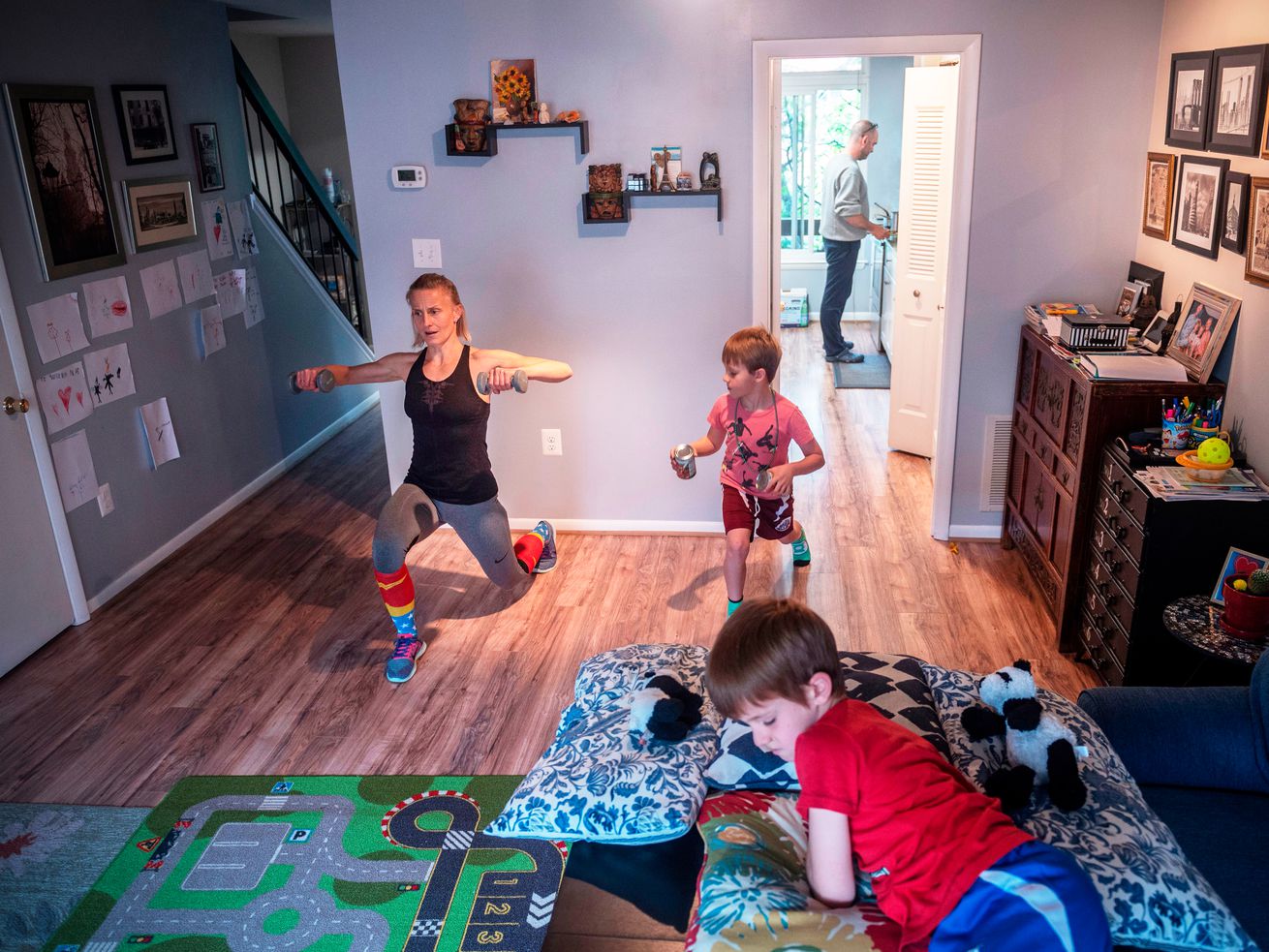Despite stress, depression, and overwork, women still want to work from home.
Women may be more likely to want to work from home than men. They’ve also had a harder time doing so, reporting higher rates of stress, depression, and sheer hours worked — especially if they have kids. This paradox is a result of women trying to do the best thing for their careers while also navigating an unfair role in society and at home. In other words, women need more flexible work arrangements, because women have more to do.
While the ability to work from home has been a godsend for working parents who were able to keep their children and jobs safe during the pandemic, it’s also exacerbated deeply ingrained gender inequality. Too often a crying toddler makes a cameo on a mother’s Zoom call and not a father’s. In a spare moment, women turn over the laundry while men don’t. Day-to-day scheduling, schooling, as well as decisions about their family’s health amid a global health crisis disproportionately fall to women.
And that’s only talking about women fortunate enough to be able to work from home — typically knowledge workers, whose relatively high-paying jobs have also afforded them a measure of physical safety. For many women, working from home isn’t an option at all. Women who have to work outside the home and care for children, especially without a partner at home, have to face a whole different set of challenging, and dangerous, circumstances.
Even before the pandemic, women were doing what sociologists describe as the “second shift,” where they complete an inordinate amount of household and caregiving chores after they’ve finished their paid labor. The pandemic has made things even worse, since much of the infrastructure that helps alleviate those tasks — schools, day care, elder care, cleaning services — has been off-limits. While women and men alike have worked from home, employed women are three times more likely than men to be their children’s main caregiver during this period. Additionally, telecommuting moms significantly increased the amount of housework they did while working from home (men didn’t).
“They literally were not having the same experience,” Alexis Krivkovich, a senior partner in McKinsey & Company’s Bay Area office and co-author of “Women in the Workplace,” a report about the female corporate workforce in 2020, told Recode. “The double shift turned into the double double.”
/cdn.vox-cdn.com/uploads/chorus_asset/file/22713348/GettyImages_1207811290t.jpg) Matthew J. Lee/The Boston Globe/Getty Images
Matthew J. Lee/The Boston Globe/Getty ImagesThe result is that women are more likely to feel burned out than men, and that has negatively affected their experience working from home. Some 79 percent of men said they have had a positive work-from-home experience during the pandemic, compared with just 37 percent of women, according to McKinsey. In turn, one in four women and one in three mothers said they were thinking about downshifting their careers or stepping out of the workforce entirely. “They couldn’t juggle the added responsibility that was coming on the household front at the same time they were trying to maintain the job front,” Krivkovich said.
Indeed, women have been leaving the workforce at much higher rates than men — a move that could affect their careers and earning power if and when they return. Some fear that with the rise of remote work, these issues will continue, even after the pandemic’s most acute effects subside.
Why women are having a worse time
Despite massive strides in education and workforce participation, caregiving and household work are still considered women’s duties. That message is reinforced by a combination of cultural norms and economic structures.
A lot of American work culture is based on a “traditional,” 1950s ideal: Men work outside the house, women stay at home with the kids. But this was never the reality for many working-class families, or families of color, across American history. And today, it’s economically necessary for both parents to do paid work for a living, even in middle-class households.
The burden of domestic labor, however, is not being shared equally among heterosexual couples.
“What we see is this drastic change in women’s behavior by entering paid work,” Caitlyn Collins, an assistant professor of sociology at Washington University in St. Louis, said of women’s movement into the workforce since the mid-1900s. “But we have not seen a similar drastic change in men’s uptake of domestic labor.”
Many antiquated ideas of women’s place in society persist. Women are more likely to be held responsible for household chores and child care, while men get to prioritize their work — despite the fact that both men and women are working.
During the pandemic, mothers have been twice as likely as fathers in a dual-career couple to do an extra five hours of domestic chores per day, according to McKinsey, which looked at the issue from June to August of 2020. Yale research shows that even in cases where both parents worked from home, women have done more household and child care work.
“A lot of women, we grow up in this environment, so we internalize these kind of norms,” said Emma Zang, a Yale assistant professor in sociology who co-authored the study. “So if you have to sacrifice a little bit from family for work, then women may feel more stressed, more frustrated compared to men, because they view that taking care of family is more of their responsibility.”
Even at senior levels, the situation is inequitable. An unpublished McKinsey survey found that while two-thirds of men in top management positions had a partner who stayed at home or who didn’t work full time, two-thirds of women in those positions had a partner who was working full time. In other words, executive women are less likely to have domestic help from their spouse.
/cdn.vox-cdn.com/uploads/chorus_asset/file/22713371/GettyImages_1322081392t.jpg) Lea Suzuki/The San Francisco Chronicle/Getty Images
Lea Suzuki/The San Francisco Chronicle/Getty ImagesThere’s also evidence that, since the pandemic began, US attitudes about gender roles have become more conservative. While people are now more likely to say women should make money than they were pre-pandemic, they’re also more likely to think women should parent young children and stay at home, according to research published in the American Sociological Association’s journal.
In addition to these cultural norms, women must also deal with economic precedents.
Employers don’t compensate women as highly as men — even in high-skill fields. If women make less than men, it’s easier for a couple to decide that the woman’s job is less important. That can lead to the woman cutting down or relinquishing her career to take care of domestic duties. Frequently it means taking on domestic duties in addition to paid labor.
“Many of the moms that we talked to, for example, were already earning less than their husbands or partners before the pandemic,” Jessica Calarco, an associate professor of sociology at Indiana University, told Recode. “And so when the pandemic hit, it seemed practical for them to be the ones to care for their children at home.”
Even when domestic tasks are done as paid labor, they’re dominated by women — and the pay is paltry.
“The reason we don’t pay caregivers well is because we don’t value caregiving, and think of it as an unskilled task, because it’s associated with femininity,” Collins said. “Secondly, we don’t think of it as skilled labor like construction. There is a belief in US society that caregiving is something you don’t have to learn how to do.”
As Calarco put it, “The labor that women are doing as caregivers has been undervalued in a way that systematically benefits men in the workplace, and allows men to better compete in their careers.”
In other words, both cultural and structural systems are stacked against women. And though remote work can in some ways seem detrimental to women, women ultimately view its flexibility as a positive development and a way to achieve equality at work.
Flexible work can be good for women
Even before the pandemic, women were clamoring for remote work, according to data from McKinsey. Generally they think its pros — giving them the ability to perform domestic tasks they do anyway and allowing them to sidestep an office-centric model more likely to benefit men — outweigh its cons. And as more people in general work remotely, lingering misgivings about remote work will likely dissolve.
The second shift existed before the pandemic, and it will exist after it, too. Remote work is an acquiescence to what is a reality for many women: doing more.
“If women feel disproportionately responsible for the household activities and for parenting, working remotely makes life a whole lot more flexible,” Jerry Jacobs, a sociology professor at the University of Pennsylvania, said.
Child care and other domestic work have been more obviously demanding during the pandemic, but they’ve always been demanding. Remote work just makes an untenable situation more possible.
“Remote work is central to allowing people with caregiving responsibilities the flexibility and control over their schedules that they need to provide that care,” Collins said.
It’s also important to remember that the office has never been particularly hospitable to women. That’s in part because office culture rewarded long hours as well as hours after work fraternizing with bosses while a partner helped out at home. It’s a situation that usually benefited men, not women.
“We need to reimagine that,” Krivkovich said. “Most women are not living that reality.”
Women were left out of conversations in the physical office, demeaned, or made to feel like they didn’t belong. Women in senior-level positions, especially Black women, are frequently the only person of their sex or race in the room, which can result in pressure to work more or feelings of otherness.
“Particularly women of color really want remote work, because it allows them to avoid some of the microaggressions that they would experience on a daily basis,” said Tara Van Bommel, director and statistician at Catalyst, a nonprofit advocating for women in the workplace.
That’s not to mention dangers like sexual harassment, which can be more acute in a physical setting.
Mothers, especially, have faced stigma in the office.
“Mothers are treated differently in the workplace than fathers,” Gayle Kaufman, a professor of sociology at Davidson College, said. “For fathers, my research suggests that they’re not even seen as fathers.”
When women become mothers, they’re expected to cut back on paid work, and it adversely affects perceptions of their career prospects. When men have kids, it’s a different story.
“If it affects them, it’s going to affect them in a good way, because they’re going to want to provide for their family,” Kaufman said, describing how men are perceived.
/cdn.vox-cdn.com/uploads/chorus_asset/file/22713406/GettyImages_1232831147t.jpg) Dania Maxwell/Los Angeles Times/Getty Images
Dania Maxwell/Los Angeles Times/Getty ImagesAll in all, the office could be a bit of a boys’ club. With this in mind, women’s experience of working from home can be better than working in the office.
“We find that remote work access diminishes burnout across three different types of burnout. And it does that for everyone, not just for women,” Van Bommel said. Employees with access to remote work had lower rates of burnout in regard to work, their personal life, and Covid-19, according to her research with Catalyst.
Remote work is, at least, more likely to keep women in the workforce.
Catalyst also found that working from home could help keep women with kids in the workforce. Women with child care responsibilities who could work remotely were 32 percent less likely to say they’re going to leave their job in the next year compared to those who couldn’t work from home. A 2013 Catalyst study of people in MBA programs found that when women didn’t have access to flexible work arrangements, they were more than twice as likely as men to downsize their career aspirations.
Some fear that remote working could hinder women’s careers since bosses might equate face time with actual work, or that it could dampen women’s likelihood of promotion since working from a distance could make them seem less involved. That’s less likely to be the case as more and more people continue working remotely.
“Working from home is going to become more common, and people will be less judgmental towards men or women who work from home,” Zang said. “If you’re less likely to be judged, then we would suppose that they will be less likely to face career consequences if they want to work from home.”
All in all, it’s certainly possible that remote work could be a good thing for women. However, it might take some effort to get it there.
“Remote work absolutely can work for women,” Krivkovich said. “What we need is to make sure that the support that allows working women to equally focus on work as their male peers is there.”
How do we make working from home more fair to women?
It’s not that remote work itself is inequitable to women. Rather, the situation in which we’re performing remote work is unjust. To ameliorate it, experts say there are a number of things the government and employers can do:
- Paid parental leave. Giving men and women paid parental leave would make it so that both sexes would learn how to care for their children, so that the burden doesn’t fall as unfairly on women. It’s also important that the amount paid parental leave compensates parents is near to all of the wages they would lose out on, to make sure both parents take it. Men, like women, have to learn how to care for children. “My research shows once they’re spending time with their kids at an early age, right off the bat, they want to be involved,” Kaufman said. “That affects how they approach their life, including work, so they start making decisions about work based on their family lives, just as mothers have done.”
- Subsidized child care. Child care, especially for young children, exists in a patchwork fashion in the US. Affordable and accessible child care is necessary to keep women from doing a disproportionate amount of it themselves while they work.
- Compensate women equally. If women were paid as much as men, their work would be less likely to play second fiddle to men’s.
- Focus on productivity, not hours logged. To make sure women aren’t punished for remote work, employers must measure work by the work itself — not how long they spend doing it. “We’re still measuring productivity in terms of inputs, not outputs, meaning we’re overly fixated on ‘can you get in a car and drive and sit at this desk where I can watch you work’ as opposed to focusing on great output of work,” Krivkovich said. “What you see with women, in part because of the pressures they feel around all the other responsibilities they hold outside of the workplace, is that breaking that assumption is just hugely valuable to them.”
- Promote people who work from home equally. Make sure there’s not a two-tier system that preferences those who can show up in the office more. As Van Bommel put it, “Tracking who’s getting advancement opportunities, who’s getting promotions, sponsorship, stretch assignments, to ensure that there’s equity regardless of people’s location, is really critical to countering that bias towards face time.”
- Be clear about remote work expectations. If working from home is going to work for women, it’s important that there are clear boundaries around how and when employees are expected to communicate, lest the flexibility of remote work simply result in more work. “I think if it’s clear that you’re not supposed to work at night, not supposed to work on weekends, any more than you were before,” Jacobs said, “that’s going to disproportionately benefit women.”
/cdn.vox-cdn.com/uploads/chorus_asset/file/22713424/GettyImages_1210450418tt.jpg) Brent Stirton/Getty Images
Brent Stirton/Getty Images
Author: Rani Molla
Read More



